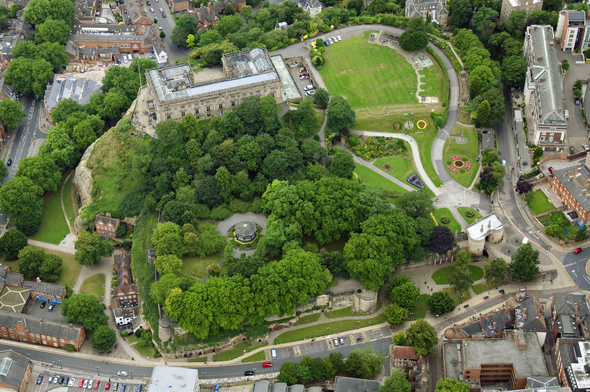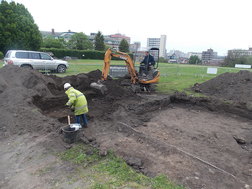 Scott's facts and findings
Welcome to Scott's eighth column. In this edition, he gives a small insight
into archaeology within the planning process...
"The application to the Heritage Lottery Fund for the transformation works at the Castle was submitted in July, and soon after, the planning application was submitted for the proposals to redevelop parts of the site.
The proposals include a new Visitor Centre, an extension within the Service Courtyard to provide a new Rebellion Gallery, plans to improve access to the caves and open up more of the Castle's caves, a new play area and various landscaping and hardscaping works."
Which areas require planning consent?
"Nottingham Castle is a highly significant site in terms of archaeology. The medieval castle was largely destroyed in 1651, and major landscaping works took place in advance of building the Ducal Palace and again during the Victorian period when renovating the Castle to form the museum and art gallery. However, significant remains of the foundations of the medieval castle survive, buried beneath the ground as well as elements of the castle that can be seen above ground such as the bridges, part of the gatehouse and the northeast tower. There are other features such as substantial ditches, which are preserved.
The site is so important that it consists of two Scheduled Monuments covering the area of the castle itself and all of the caves cut into the Castle Rock. Scheduled Monument status recognises the national importance of the site and the significant surviving remains"
What work has been done?
"As such great consideration has been given to the impact of the proposals upon buried archaeological remains. A team of archaeologists has been working at the Castle since April and some of their findings were included in last month's newsletter. The results are currently being studied in detail and reports are being written. The preliminary results have been used to help guide the proposed developments by identifying ways in which development can take place in such a way that it minimises the impact of the building works on the archaeology. They also provide a better idea of what further archaeological work is needed."
|

Who grants permission?
"Any development that impacts significant archaeology in the city is looked at by the City Council's planning archaeologist who advises the planning department about whether a development is acceptable and what archaeological work is required. Any remains (features, structural remains or deposits) that significantly contribute to our understanding of the Castle have to be preserved but development can go ahead provided appropriate archaeological investigations take place. The detailed plans have now been carefully looked at to make sure the archaeology is fully considered and a comprehensive strategy written for its investigation.
In addition to planning permission, because the site is Scheduled, permission is also needed from the Secretary of State for Culture, Media and Sport. The Secretary of State receives advice from Historic England when reaching a decision. If the Secretary of State grants permission this is known as Scheduled Monument Consent."
What happens if/when permission is granted?
"If planning permission is granted, and the Secretary of State grants Scheduled Monument Consent, not only will the Visitor Centre, Rebellion Gallery, greater access to more caves and other changes offer a greater visitor experience, but the excavations and other archaeological work will offer the opportunity to learn a great deal about the development of the Castle from when it was built shortly after the Norman Conquest, to its destruction in the 17th Century and the development of the site as the home of the Duke of Newcastle, and later the museum."
 Skeleton update
"In last month's
article I wrote that further details would be revealed about the skeleton found
on the Green, which had long been thought to be a casualty of the English Civil
War.
The radiocarbon dating has been completed by the Oxford Radiocarbon
Accelerator Unit and the results will be revealed soon.
We intend to carry out
further tests later this year to find out details of the man's diet and
whereabouts in the country he was born."
|
|